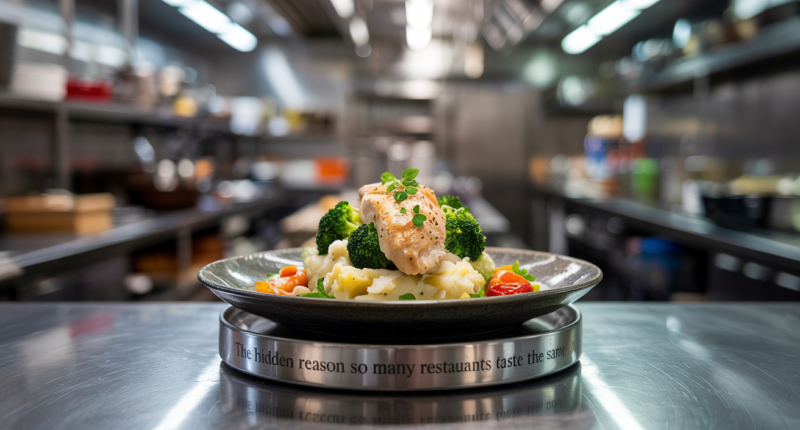Why Restaurant Menus Taste Alike
Today many dining spots feel more similar than different. Indeed, diners often say menu items are interchangeable. Experts blame global supply chains and big food trends for this sameness. First, distributors push identical ingredients and recipes to kitchens everywhere. For example, chefs ordering from large food companies often get the same products – from bulk spices to filler-added proteins. In fact, one chef bluntly observed that meals using these generic ingredients “aren’t trying very hard to be any good”.
Global Supply Chains and Uniform Ingredients

Global food distributors make sourcing easy but flavor uniform. Because companies like Sysco supply both chains and independents, menus often share the same base. For instance, these large distributors favor engineered produce and preservatives to ensure consistency. As a result, even local bistros may use the same farmed salmon or bland bagels as chains. Moreover, restaurateurs note that suppliers push the cheapest (and therefore blandest) ingredients, making dishes taste flat.
Chains and Franchises: Consistent Menus at Scale
Major franchises amplify sameness by design. In fact, chains build success on predictability. For example, burger and coffee brands use standard recipes so a meal tastes the same everywhere. Similarly, analysts note that the ten largest chains account for 44% of top chain sales, meaning their menu staples dominate options. Moreover, writers describe the “chain model” as one that “prizes consistency of product over specialization”westword.com. As a result, menus everywhere feature familiar items — burgers, rice bowls or pasta — whether you dine in New York or Nairobi.
Trends, Tech, and Social Media Influence
Meanwhile, modern trends and technology encourage chefs to follow the crowd. As a result, many restaurants chase viral food ideas rather than local tradition. For instance, a food trend report found diners today “are eating global” and expecting dishes inspired by world cuisinesfoodrepublic.com. However, this often means menus just remix familiar elements (like spicy mayo, kimchi or avocado) in slightly different ways. In addition, social media’s “foodie” culture rewards Instagrammable looks, so restaurants tend to mimic popular trends in their dishes. All together, even this internet-driven creativity leans on the same base, so many new dishes end up tasting the same.
Expert Insights on Homogenized Tastes
Professional chefs and critics have noticed the shift. Many chefs argue that profit-driven systems squeeze local character out of cooking. For example, one chef warned that cheap, widely distributed inputs make meals bland and low-qualitythenation.com. Food critics similarly note that global dining fads lead to redundancy: similar salads or noodle bowls appear everywhere. Furthermore, award-winning writers observed that it can be hard to guess a dish’s origin with eyes closed — so generic have many menus become.
Finding real flavor again may mean looking beyond the mainstream. Ultimately, restaurants that showcase local ingredients or chefs who innovate beyond mass-market supplies can stand out. Even so, understanding these trends explains why global dining is more standardized and helps food lovers seek distinctive tastes.









